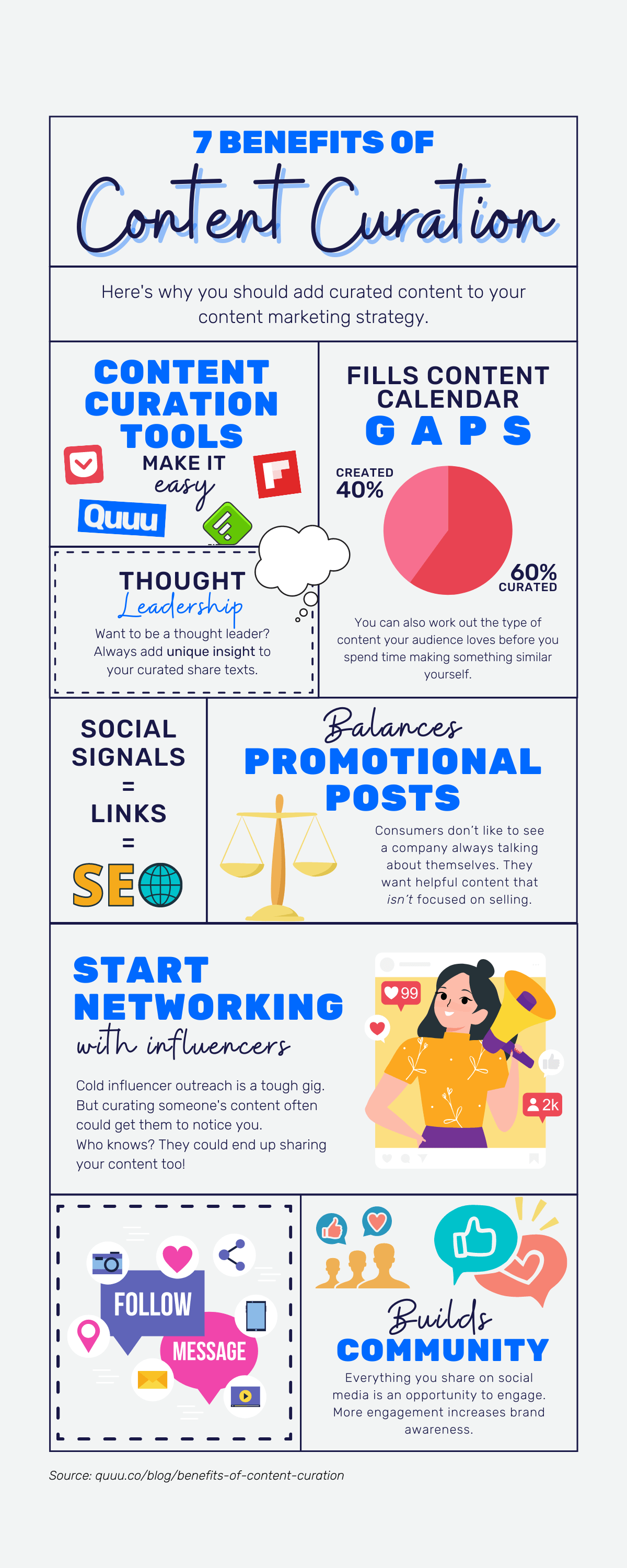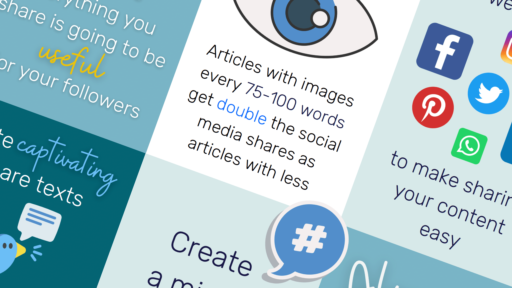To succeed on social media, you need quality content – and lots of it! But if you don’t have a team or time to dedicate to content creation, it can feel pointless even trying.
This is where curated content can fill in the gaps.
Content curation is simply sharing content that other people have made. But to benefit you and your audience.
It can be as simple as a retweet, but we recommend making it more valuable. (We’ll get to that soon!) Curation will upgrade your current content marketing strategy. It can be easy. It can be free!
Here are 7 benefits of content curation for social media:
- Curating keeps your content calendar full
- You can become a thought leader by adding unique insight
- Content curation tools can give you quality content to share
- It mixes up original content, so you don’t look too self-promotional
- Curated content increases social signals (linked to SEO)
- It’s a great opener to start networking with influencers
- It can increase engagement and build a community

1. Curated content keeps your content calendar full
One of the most obvious content curation benefits is how it can work alongside original content. If you don’t have the many hands of a marketing team, you’ll still always have content for social media posts.
Sure, you have to put a bit of effort into finding exactly what you’re going to share. It’s got to be relevant, high-quality content your target audience is interested in. But you don’t have to go trawling aimlessly through search engines.
There are plenty of more focused sources:
- RSS feeds and aggregation apps
- Twitter (forget algorithms – try hashtags, trending topics, and Lists)
- Email newsletters
- Community forums and groups
- Your personal network
- Podcasts (e.g. Apple Music/Spotify)
- YouTube

Source: Twitter
It’s also a great way of finding out the type of content your audience loves before you take the time to make something similar yourself!
Hootsuite recommends:
“While the ideal ratio will vary by industry and organization, a good rule of thumb is to share 40% created and 60% curated content, making adjustments to this ratio as you discover what resonates best with your audience.”
Once you’ve found the perfect content, you can share it there and then. Or you try our next tip – the first step to thought leadership.
2. You can become a thought leader by adding unique insight
Anyone can hit the retweet button. Most of us do. But where’s the value in that for your target audience if it’s all you’re doing? They may as well follow the source.
This easy hack will take your curated content to the next level.
Thought leaders are industry experts in their niche. They usually have a dedicated following because of their unique points of view. The best content curators know that to be someone worth following, they need to provide valuable information.

Source: Twitter
Whenever you curate content for social media, make sure to add a personal twist to your share texts. Try things like:
- Asking a question
- Giving your opinion (even if it’s different from the content)
- Quoting or picking out a stat
- Briefly summarizing why people should read
There’s no set template for formats, though. The more creative you can get – the better!
3. Content curation tools can give you quality content to share
Another one of the benefits of content curation is how easy it can be.
Let’s take a step back to finding content to curate. There are so many content curation tools out there that can give you as much (or as little) help as you need.
Do you want a mix of great content on specific topics sent straight to you? That you can share or schedule to your social media platforms from the same dashboard? If that sounds like your kinda thing, check out Quuu. It works with Twitter, Facebook, and LinkedIn.

If you’d like to take more time to browse relevant feeds yourself, you might want to try Scoop.it or Feedly. Or, if you just want a handy tool to make bookmarking content you find easier, try Pocket.
If it’s world news stories you’re interested in sharing, head on over to Flipboard. Or, for more underground content directly from groups of users in your industry, try joining some Tribes on Triberr.
These are some of our favorites, and they’re top-rated by most people. So, get exploring!
4. It mixes up original content, so you don’t look too self-promotional
Creating your own content is a must for success in digital marketing and lead generation. According to Startup Bonsai, content marketing generates 3x as many leads as traditional marketing. And it costs 62% less!

Source: Startup Bonsai
But even the best bloggers know they shouldn’t talk about themselves or their business all the time. Another benefit of content curation is that it makes your social media posts look way more balanced. When it comes to self-marketing, there’s a fine line between showing your skills and simply boasting about them.
Carefully selecting valuable content to curate shows you know what you’re talking about. You’re not trying to push yourself in any way, but you are showing that you know entertaining or educational content when you see it.
Consumers don’t like to see a company constantly talking about themselves. It’s why indirect advertising is so popular nowadays. People want helpful content that isn’t focused on selling.
5. Curated content increases social signals (linked to SEO)
Unlike most ranking factors, curation has a less obvious effect on SEO (search engine optimization). But according to Search Engine Journal:
“A well-executed content curation strategy results in social shares, links, and ultimately better rankings.”
Now, a single tweet is unlikely to give you these kinds of results. This is for bulkier online content, like blog posts, that you can then share on social media.
Some examples include:
- Article, podcast, and video roundups
- Condensing large datasets into quick stats (e.g. “B2B Marketing Stats”)
- Summarizing complicated whitepapers and reports
- Expert roundups from your industry
- Listicles (e.g. “Content Curation Tools for 2022”)

Source: HubSpot
A well-researched, thought-out curated post that’s shared on social media can result in a LOT of backlinks. And backlinks are most definitely a direct ranking factor.
But what about social signals themselves? Do they have an impact? Well…it’s complicated. But that’s a whole other blog post.
6. It’s a great opener to start networking with influencers
A share from an influencer can be one of the most powerful forms of online marketing. But cold influencer outreach is a tough gig. But what if there was a way to naturally start a mutually-beneficial relationship? One that didn’t start with you asking for anything?
Well, there is. Curating their content.
By regularly curating and engaging with your favorite influencer’s content, it could be enough for them to notice you. Maybe they’ll engage back. Maybe they’ll retweet it. Maybe they’ll eventually share something of yours.
The thing is, there are no guarantees this will work. But it doesn’t matter, because there’s no downside!
Best case scenario, you start and develop a relationship with a thought leader in your industry. Worst case, you don’t. But you’ve still shared some amazing, relevant content with your audience.
If you’re not sure where to start, try checking out some of the biggest blogs in your industry and find out who founded them.
For example, if you were in content marketing:
- Copyblogger (Brian Clark)
- HubSpot (Dharmesh Shah and Brian Halligan)
- Content Marketing Institute (Joe Pulizzi)
- Moz (Rank Fishkin)
Check out their blogs and profiles. Then find their social media accounts and tag them when you share anything they’ve created. The golden rule of curation? Always credit the source.
7. It’s a way to increase engagement and build a community
Social media engagement and a dedicated community are two of the best ways of spreading brand awareness. But to build those, you need a lot of content.
Everything you share on social media is an opportunity to engage with your audience. As we’ve learned, curation gives you plenty to keep your feeds full.
Solid engagement leads to community. Curated content can help you establish a dedicated one by:
- Capturing people’s interest
- Showing your account is an expert resource of valuable content
- Educating your target audience on the problem your brand aims to solve
- Building trust and credibility by referencing those already well-known in your industry
Did you know that engaging on social media can also affect SEO? You’ve probably guessed how – brand awareness leads to backlinks!

Give your audience a ton of content to digest. Things that’ll make them want to get involved in the conversation. That’s one of the final benefits of content curation.
Conclusion
Are you wondering if you should add curation to your social media strategy? Maybe you’re writing a blog post and need to learn about some of the benefits?
Either way, here are the 7 main benefits of content curation:
- Curating keeps your content calendar full
- You can use it to become a thought leader
- Content curation tools do the hard work for you
- It breaks up self-promotional content
- You’ll increase your social signals (linked to SEO)
- It’s a great way to start networking with influencers
- You will keep on top of trending topics
Sharing other people’s content can (and will!) benefit your social media marketing campaigns. Everything you post is an opportunity to increase your brand awareness – even if it’s from other people.
Is curation part of your content marketing strategy? Why do you curate content on social media? We’d love to know more!





